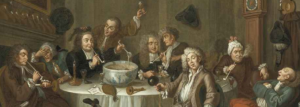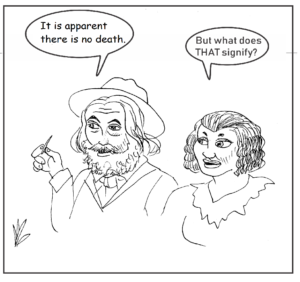3 Poetry as Conversation

In chapter three, we noted that poetry is part of a continual tradition which is conscious of the fact that it is a tradition—in other words, that poets of every era have carefully read the poets not only of their own time but also of the past. As we said then, certain features of poetry make it possible to think of poems as always and everywhere the same thing. We learned then that ignoring the history of poetry affords us certain insights into the craft. It is a perfectly legitimate thing to do. It forces us to see certain things that we might otherwise be distracted from. But it’s also true that paying attention to history will allow us to see things that we miss when we ignore it. So this week we want to bring some history into our discussion.
Poets are always reacting in various ways to their predecessors and their contemporaries as though they were all contemporary. One prominent literary critic named Harold Bloom has argued that the primary driving force in the best poets of any age is the drive to overthrow the best poets that came before them. So a nineteenth-century poet like William Wordsworth, according to Bloom, feels as though he is in competition with a premier eighteenth-century poet like Alexander Pope even though Pope was already dead before Wordsworth began writing. The history of poetry, according to Bloom, is a struggle for supremacy with each “strong” poet of every time trying to place himself at the center of the whole history of poetry.
A lot of readers disagree with Bloom’s way of describing the history of poetry. But whether Bloom is right or not about the struggle for supremacy, he is certainly right to perceive that poets respond to other poets in their poems. For our purposes it will be more useful to describe this relationship as a conversation than as a struggle because it allows us to think about other kinds of responses than the search for dominance. But we should keep in mind that part of conversation is struggle, and that no poet responds to an earlier poet merely to agree with him or her.
Any poet of any skill must see him or herself in the context of the history of poetry. This on-going conversation among poets is not the essence of poetry any more than the things we’ve mentioned in previous chapters are. Nonetheless, conversation is so pervasive an aspect of the poetic tradition that we will have a hauntingly incomplete understanding of what poetry is if we do not notice it and think about it. In fact, failing to recognize the status of a particular poem in relation to the poetic tradition is another reason why poetry often frustrates students. Reading poems is often like coming in on a conversation in the middle. If someone doesn’t help you get caught up, you may well miss the point.
Let us look at an example. First, read this poem by William Wordsworth:
My Heart Leaps Up
My heart leaps up when I behold
A rainbow in the sky:
So was it when my life began,
So is it now I am a man,
So be it when I shall grow old
Or let me die!
The Child is father of the Man:
And I could wish my days to be
Bound each to each by natural piety
You could read this poem ahistorically and enjoy it. But something else happens when you think about it as part of an historical conversation.
According to this poem, the poet’s heart reacts to rainbows in a particular way: it leaps up. To understand this simple-sounding statement as more than a sentimental enjoyment of rainbows, you will need a certain understanding of the movement in literature known as Romanticism—which may be thought of as the name of the conversation going on among poets and other writers of the time. We will cover this in detail a later chapter. For now it will be enough to gloss a few terms.
By “heart,” Wordsworth includes not just the organ associated with love but something closer to his soul, the essence of his being, which includes here his capacity to imagine. The rainbow in line two is a synecdoche for nature. It’s not just rainbows that affect this poet this way, but all of nature. The rainbow is a good choice to illustrate this because rainbows come upon us unexpectedly. But Wordsworth will have in his poetry other examples in which he is suddenly confronted with some natural phenomenon that affects him as this rainbow does. Finally, “leaps up,” tells us that his reaction to nature is sudden, spontaneous, out of his control. There is an affinity between his essential being and nature that makes him wish to join it whenever he recognizes it like a dog that leaps when he sees his master.
All the great poets from Wordsworth’s time have similar images of nature in their poems, each with a different emphasis that marks that poet’s contribution to the conversation.
The first thing I want you to understand is that this information is not something the poem is likely to reveal at first glance without someone telling you. Secondly, and still more importantly for our purposes, Wordsworth is reacting both to the poems of other writers of his time and to earlier nature poetry, such as that of Thomas Grey. Here are some lines of his:
In vain to me the smiling mornings shine,
And reddening Phoebus lifts his golden fire:
The birds in vain their amorous descant join,
These ears alas! for other notes repine;
A different object do these eyes require;
My lonely anguish melts no heart but mine;
And in my breast the imperfect joys expire;
Did you notice how much easier Wordsworth’s lines were to understand than Grey’s? That’s one way Wordsworth is reacting to Grey. Grey was fond of what is called “poetic diction,” which includes using fancy sounding words to describe ordinary things (saying “reddening Pheobus” instead of “the rising sun”). This was very popular in Grey’s century. But Wordsworth detested it, and he wrote his poems to show that you don’t have to do that to write good poetry. Grey’s poem is about his inability to respond to nature (because someone has died in his case). Wordsworth’s poem is about his inability not to respond to nature. Wordsworth is saying to Grey, “If you can’t respond to nature it may not be because your friend died but because of the weird way you think about it, how you cover it up with words instead of revealing it.”
Let’s look at another example that is even clearer. Here’s a poem by Edna St. Vincent Millay, who wrote a century after Wordsworth.
Spring
To what purpose, April, do you return again?
Beauty is not enough.
You can no longer quiet me with the redness
Of little leaves opening stickily.
I know what I know.
The sun is hot on my neck as I observe
The spikes of the crocus.
The smell of the earth is good.
It is apparent that there is no death.
But what does that signify?
Not only under ground are the brains of men
Eaten by maggots.
Life in itself is nothing,
An empty cup, a flight of uncarpeted stairs.
It is not enough that yearly, down this hill,
April
Comes like an idiot, babbling and strewing flowers.
This poem is also about nature. It is not a specific reaction to Wordsworth’s poem, but it is a reaction to the large body of “Romantic” nature poetry produced during the nineteenth century. These poems, including Wordsworth’s, try to reassure us that, to put it in very simple terms, the divine can be found in nature. Millay sees the same thing that Wordsworth sees: natural beauty. When she says that spring comes “strewing flowers,” she acknowledges this. She does not deny that spring is an extraordinary time. But she sees, or rather looks at, things that Wordsworth and other Romantic poets overlook: heat and maggots in particular. Nature for her does not convey a message from God; no, it babbles like an idiot. And when she says “it is apparent there is no death” she is quoting a line from another Romantic poet, one who in his turn had responded to Wordsworth. In this case it is the American Romantic poet Walt Whitman who, in Song of Myself, “6,” wrote:
“The smallest sprout shows there is really no death.”
Millay replies to Whitman’s statement of faith with a snarky: “But what does that signify?” She’s not buying Whitman’s or Wordsworth’s Romantic optimism about nature.
Obviously, it helps to know these things. If we learn to see the allusion twentieth-century poems make to Romanticism, we’ll understand those poems more easily, just as we’ll understand the works of Romantic poets more easily if we see how they are reacting to eighteenth-century “Neoclassicism.” As readers, it helps to become part of the conversation for two reasons: first to avoid confusion. Readers commonly feel a sense of confusion when they do not see what words the words in front of them are responding to. Secondly, to get the fullest meaning from the words that they offer us. A poem like Millay’s or Wordsworth’s can give pleasure even if it is the only poem you’ve ever read. But it gives a much fuller experience if you perceive their places in ongoing conversations.
We’ve only scratched the surface here of how poets respond to each other. We will pursue this issue further in future discussions. As you read the course poems, see what other ways of responding you can identify. Think about the conversation that you as a reader of poetry are entering.

